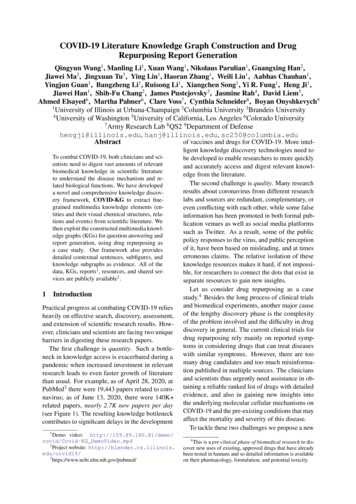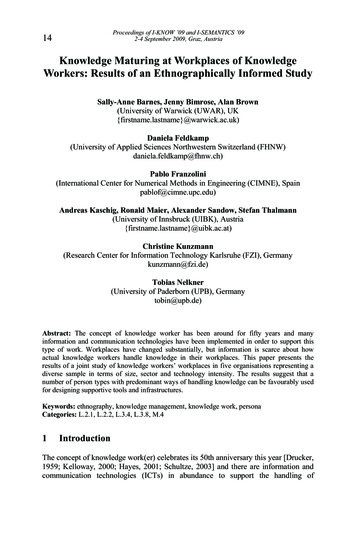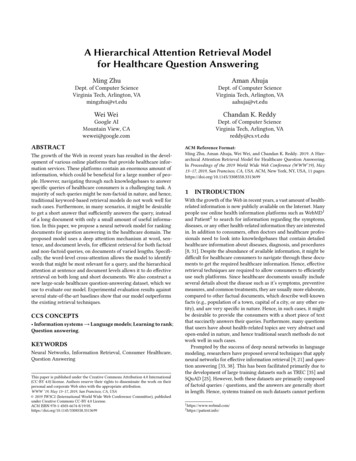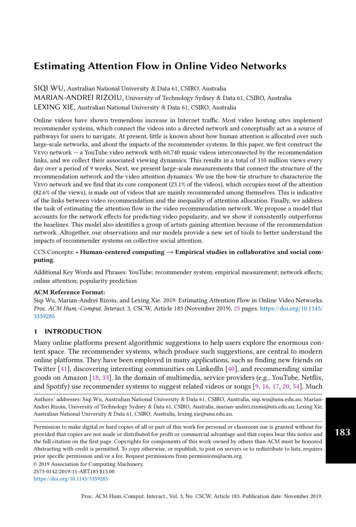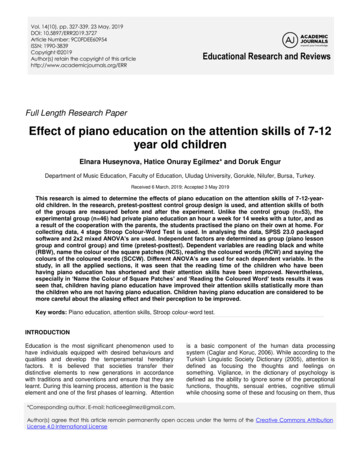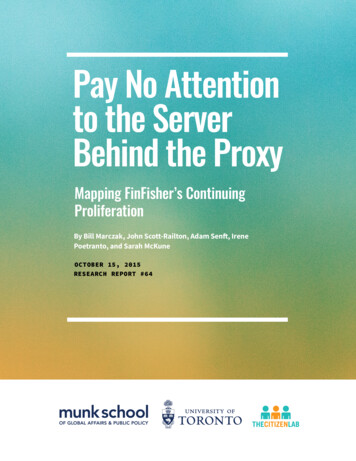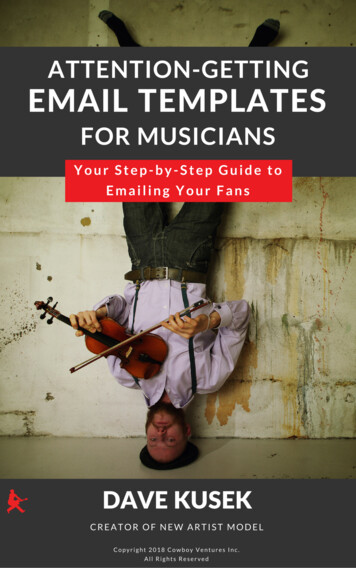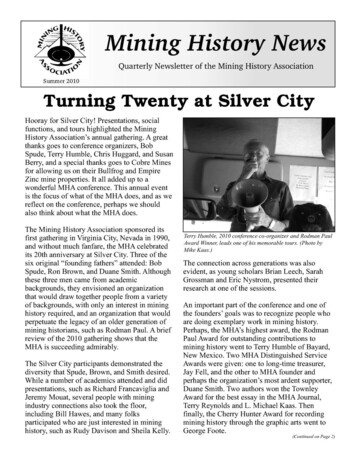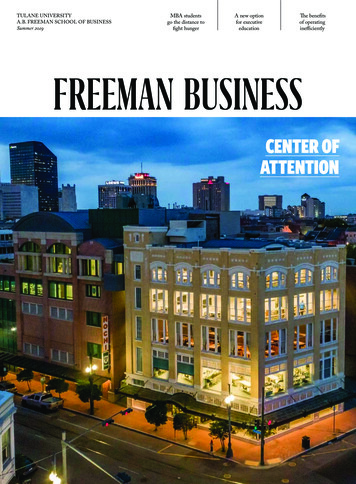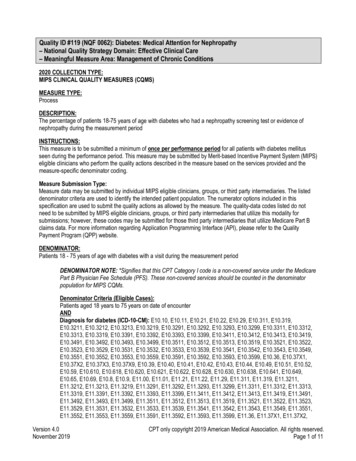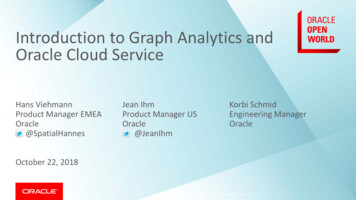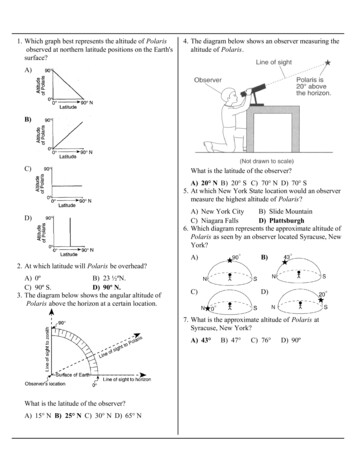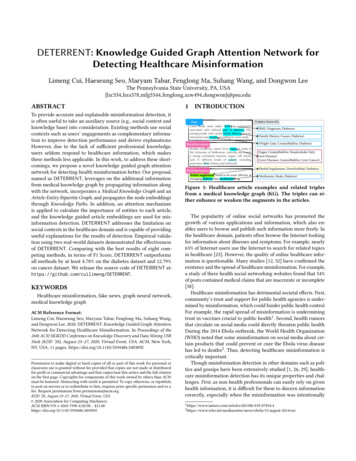
Transcription
DETERRENT: Knowledge Guided Graph Attention Network forDetecting Healthcare MisinformationLimeng Cui, Haeseung Seo, Maryam Tabar, Fenglong Ma, Suhang Wang, and Dongwon LeeThe Pennsylvania State University, PA, @psu.eduABSTRACTTo provide accurate and explainable misinformation detection, itis often useful to take an auxiliary source (e.g., social context andknowledge base) into consideration. Existing methods use socialcontexts such as users’ engagements as complementary information to improve detection performance and derive explanations.However, due to the lack of sufficient professional knowledge,users seldom respond to healthcare information, which makesthese methods less applicable. In this work, to address these shortcomings, we propose a novel knowledge guided graph attentionnetwork for detecting health misinformation better. Our proposal,named as DETERRENT, leverages on the additional informationfrom medical knowledge graph by propagating information alongwith the network, incorporates a Medical Knowledge Graph and anArticle-Entity Bipartite Graph, and propagates the node embeddingsthrough Knowledge Paths. In addition, an attention mechanismis applied to calculate the importance of entities to each article,and the knowledge guided article embeddings are used for misinformation detection. DETERRENT addresses the limitation onsocial contexts in the healthcare domain and is capable of providinguseful explanations for the results of detection. Empirical validation using two real-world datasets demonstrated the effectivenessof DETERRENT. Comparing with the best results of eight competing methods, in terms of F1 Score, DETERRENT outperformsall methods by at least 4.78% on the diabetes dataset and 12.79%on cancer dataset. We release the source code of DETERRENT Healthcare misinformation, fake news, graph neural network,medical knowledge graphACM Reference Format:Limeng Cui, Haeseung Seo, Maryam Tabar, Fenglong Ma, Suhang Wang,and Dongwon Lee. 2020. DETERRENT: Knowledge Guided Graph AttentionNetwork for Detecting Healthcare Misinformation. In Proceedings of the26th ACM SIGKDD Conference on Knowledge Discovery and Data Mining USBStick (KDD ’20), August 23–27, 2020, Virtual Event, USA. ACM, New York,NY, USA, 11 pages. https://doi.org/10.1145/3394486.3403092Permission to make digital or hard copies of all or part of this work for personal orclassroom use is granted without fee provided that copies are not made or distributedfor profit or commercial advantage and that copies bear this notice and the full citationon the first page. Copyrights for components of this work owned by others than ACMmust be honored. Abstracting with credit is permitted. To copy otherwise, or republish,to post on servers or to redistribute to lists, requires prior specific permission and/or afee. Request permissions from permissions@acm.org.KDD ’20, August 23–27, 2020, Virtual Event, USA 2020 Association for Computing Machinery.ACM ISBN 978-1-4503-7998-4/20/08. . . DUCTIONFactLower body mass index (BMI) is consistentlyassociated with reduced type II diabetes risk,among people with varied family history, geneticrisk factors and weight, according to a new study.Triples from KG(BMI, Diagnoses, Diabetes)(Family History, Causes, Diabetes)MisinformationBesides chemicals, cancer loves sugar. A study atthe University of Melbourne, Australia discovereda strong correlation between sugary soft drinksand 11 different kinds of cancer, includingpancreatic, liver, kidney, and colorectal.(Weight Gain, CreatesRiskFor, Diabetes)MisinformationHerbal supplement found to be more effective atmanaging diabetes than metformin drug.(Herbal Supplement, DoesNotHeal, Diabetes)(Sugar, CreatesRiskFor, Nonalcoholic FattyLiver Disease)(Liver Diseases, CreatesRiskFor, Liver Cancer)(Metformin, Heals, Diabetes)Figure 1: Healthcare article examples and related triplesfrom a medical knowledge graph (KG). The triples can either enhance or weaken the augments in the articles.The popularity of online social networks has promoted thegrowth of various applications and information, which also enables users to browse and publish such information more freely. Inthe healthcare domain, patients often browse the Internet lookingfor information about illnesses and symptoms. For example, nearly65% of Internet users use the Internet to search for related topicsin healthcare [25]. However, the quality of online healthcare information is questionable. Many studies [12, 32] have confirmed theexistence and the spread of healthcare misinformation. For example,a study of three health social networking websites found that 54%of posts contained medical claims that are inaccurate or incomplete[38].Healthcare misinformation has detrimental societal effects. First,community’s trust and support for public health agencies is undermined by misinformation, which could hinder public health control.For example, the rapid spread of misinformation is underminingtrust in vaccines crucial to public health1 . Second, health rumorsthat circulate on social media could directly threaten public health.During the 2014 Ebola outbreak, the World Health Organization(WHO) noted that some misinformation on social media about certain products that could prevent or cure the Ebola virus diseasehas led to deaths2 . Thus, detecting healthcare misinformation iscritically important.Though misinformation detection in other domains such as politics and gossips have been extensively studied [1, 26, 29], healthcare misinformation detection has its unique properties and challenges. First, as non-health professionals can easily rely on givenhealth information, it is difficult for them to discern informationcorrectly, especially when the misinformation was intentionally1 2 st-2014/en/
made to target such people. Existing misinformation detectionfor domains such as politics and gossips usually adopt social contexts such as user comments to provide auxiliary information fordetection[8, 13, 16, 36, 39]. However, in healthcare domain, socialcontext information is not always available and may not be usefulbecause of users without professional knowledge seldom respondto healthcare information and cannot give accurate comments. Second, despite good performance of existing misinformation detectionmethods [42], the majority of them cannot explain why a piece ofinformation is classified as misinformation. Without proper explanation, users who have no health expertise might not be able toaccept the result of the detection. To convince them, it is necessaryto offer an understandable explanation why certain information isunreliable. Therefore, we need some auxiliary information that can(1) help detect healthcare misinformation; and (2) provide easy tounderstand professional knowledge for an explanation.Medical knowledge graph, which is constructed from research papers and reports can be used as an effective auxiliary for healthcaremisinformation detection, to find the inherent relations betweenentities in texts to improve detection performance and provide explanations. In particular, we take the article-entity bipartite graphand medical knowledge graph as complementary information, intoconsideration to facilitate a detection model (See Figure 1). First,article contents contain linguistic features that could be used to verify the truthfulness of an article. Misinformation (including hoaxes,rumors and fake news) is intentionally written to mislead readersby using exaggeration and sensationalization verbally.For example, we can infer from a medical knowledge graph that𝑆𝑢𝑔𝑎𝑟 is not directly linked to 𝐿𝑖𝑣𝑒𝑟 𝐶𝑎𝑛𝑐𝑒𝑟 , however, the misinformation indicates that there is a “strong correlation” between thetwo entities. Second, the relation triples from a medical knowledgegraph can add/remove the credibility of certain information, andprovide explanations to the detection results. For example, in Figure 1, we can see that the triple (𝐵𝑀𝐼 , 𝐷𝑖𝑎𝑔𝑛𝑜𝑠𝑒𝑠, 𝐷𝑖𝑎𝑏𝑒𝑡𝑒𝑠) andtwo more triples can directly verify that the article is real, whilethe triple (𝐻𝑒𝑟𝑏𝑎𝑙 𝑆𝑢𝑝𝑝𝑙𝑒𝑚𝑒𝑛𝑡, 𝐷𝑜𝑒𝑠𝑁𝑜𝑡𝐻𝑒𝑎𝑙, 𝐷𝑖𝑎𝑏𝑒𝑡𝑒𝑠) can provethat the saying in an article is wrong. Above all, it is beneficial toexplore the medical graph for healthcare misinformation detection.And to our best knowledge, there is no prior attempt to detecthealthcare misinformation by exploiting the knowledge graph.Therefore in this paper, we study a novel problem of explainablehealthcare misinformation detection by leveraging the medicalknowledge graph. Modeling the medical knowledge graph withhealthcare articles is a non-trivial task. On the one hand, healthcareinformation/texts and medical knowledge graph cannot be directlyintegrated, as they have different data structures. On the otherhand, social network analysis techniques are not applied to themedical knowledge graph. For example, recommendation systemswould recommend movies to users who watched a similar set ofmovies. However, in the healthcare domain, two medications arenot necessarily related even if they can heal the same disease.To address the above two issues, we propose a knowledge guidedgraph attention network that can better capture the crucial entitiesin news articles and guide the article embedding. We incorporate theArticle-Entity Bipartite Graph and a Medical Knowledge Graph intoa unified relational graph and compute node embeddings alongthe graph. We use the Node-level Attention and BPR loss [30] totackle the positive and negative relations in the graph. The maincontributions of the paper include: We study a novel problem of explainable healthcare misinformation detection by leveraging medical knowledge graph to bettercapture the high-order relations between entities; We propose a novel method DETERRENT (knowleDgE guidedgraph aTtention nEtwoRks foR hEalthcare misiNformationdeTection), which characterizes multiple positive and negative relations in the medical knowledge graph under a relational graphattention network; and We manually build two healthcare misinformation datasets ondiabetes and cancer. Extensive experiments have demonstratedthe effectiveness of DETERRENT. The reported results show thatDETERRENT achieves a relative improvement of 1.05%, 4.78% onDiabetes dataset and 6.30%, 12.79% on Cancer dataset comparingwith the best results in terms of Accuracy and F1 Score. The casestudy shows the interpretability of DETERRENT.2RELATED WORKIn this section, we briefly review two related topics: misinformationdetection and graph neural networks.Misinformation Detection. Misinformation detection methodsgenerally focus on using article contents and external sources. Article contents contain linguistic clues and visual factors that candifferentiate the fake and real information. Linguistic features basedmethods check the consistency between the headlines and contents[4], or capture specific writing styles and sensational headlines thatcommonly occur in fake content [28]. Visual-based features canwork with linguistic features to to identify fake images [42], andhelp to detect misinformation collectively [9, 13].For external sources based approaches, the features are mainlycontext-based. Context-based features represent the informationof users’ engagements from online social media. Users’ responsesin terms of credibility [31], viewpoints [36] and emotional signals[9] are beneficial to detect misinformation. The diffusion networkconstructed from users’ posts can evaluate the differences in thespread of truth and falsity [41]. However, users’ engagements arenot always available when a news article is just released, or userslack professional knowledge of relevant fields such as medicine.Knowledge graph (KG) can address the disadvantages of currentmethods relying on social context and derive explanations to thedetection results. Some researchers use knowledge graph basedmethods to decide and explain whether a (Subject, Predicate, Object)triple is fake or not [7, 15, 17]. These methods use the score functionto measure the relevance of the vector embedding of subject andvector embedding of object with the embedding representation ofpredicate. For example, KG-Miner exploits frequent predicate pathsbetween a pair of entities [35]. Other researchers use news streamsto update the knowledge graph [37].Hence in this paper, we study the novel problem of knowledgeguided misinformation detection, aiming to improve misinformation detection performance in healthcare, and provide a possibleinterpretation on the result of detection simultaneously.Graph Neural Networks. Graph Neural Networks (GNNs) refer tothe neural network models that can be applied to graph-structured
data. Several extensions to GNN [33] have been proposed to enhance the capability and efficiency [43]. GCN [20] attempts to learnnode embeddings in a semi-supervised fashion using a differentneighborhood aggregation method. GAT [40] extends GNN by incorporating the attention mechanism. R-GCN [34] is also a variantof GCN which is suitable for relational data. RGAT [6] takes advantage of both the attention mechanism and R-GCN and attemptsto extend the attention mechanism to the area of relational graphstructured data. Signed Networks are variants of GNNs applicableto the signed graphs with negative and positive edges [10, 22, 23].However, existing methods are not suitable for modeling thepositive and negative relations in the medical knowledge graph, asmentioned in the introduction. In this work, we model the medicalknowledge graph under a relational graph attention network, anduse BPR loss to capture positive and negative relations.3PROBLEM FORMULATIONIn this section, we describe the notations and formulate medical knowledge graph guided misinformation detection problem.The medical
and the knowledge guided article embeddings are used for mis-information detection. DETERRENT addresses the limitation on social contexts in the healthcare domain and is capable of providing useful explanations for the results of detection. Empirical valida-tion using two real-world datasets demonstrated the effectiveness of DETERRENT. Comparing with the best results of eight com-
